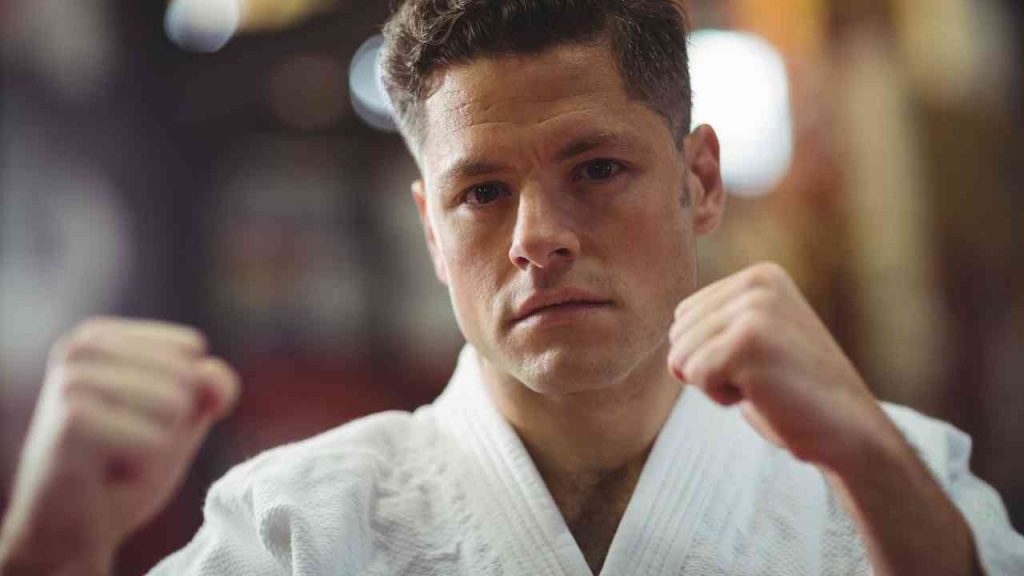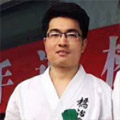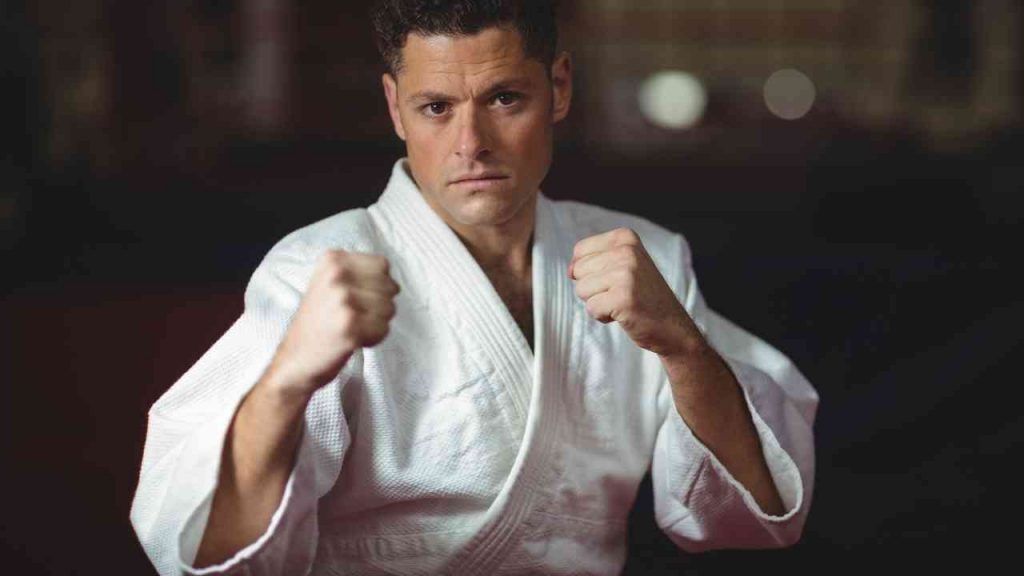Kenpo is one of the several martial art forms which developed in Asia. It has roots both in Chinese and Japanese martial arts and is commonly associated with modern-day Karate. The most common form of Kenpo is American Kenpo and is widely taught in the US.
Other original forms are still taught in other countries, but they are slightly distinct and less aggressive. Asian Kenpo masters do not consider American Kenpo to be a real style of martial art as it was made by Ed Parker combining numerous different techniques of martial arts thus losing its originality.
Table of Contents
- History of Kenpo karate
- Is it Kenpo or Kempo?
- Difference Between Kenpo and Karate
- Kenpo styles
- Kenpo karate belt order
- Kenpo karate techniques
- What is American Kenpo?
- What is Chinese Kenpo?
- What is Japanese Kenpo?
- What is the difference between American Kenpo, Chinese Kenpo, and Japanese Kenpo?
- Kenpo karate weapons
- Is Kenpo effective in a street fight?
- To Wrap it Up
History of Kenpo karate
In 1916, a young five-year-old boy, James Mitose was sent to Kyushu, Japan from Hawaii to learn his ancestor’s self-defense art form called Koshu-Ryu Kenpo. Kosho-Ryu Kenpo was introduced by two families in the 17th century called Kumamoto and Nagasaki.
They brought the knowledge of Kenpo from China to Kyushu in Japan. After finishing his training in Japan, Mitose returned to Hawaii and opened a self-defense club in Honolulu called ‘Official Self-Defense’. It was from there the 5 major influencers of Kenpo emerged, namely,
- Thomas Young
- William K. S. Chow
- Edmund Howe
- Arthur Keawe
- Paul Yamaguchi
William K.S. Chow is responsible for Americanizing the art form. He opened his own school in 1949 where Edmund K. Parker became his student at the age of 16. Parker combined this method with other martial art techniques and opened the first commercial Karate studio in 1954.
Is it Kenpo or Kempo?
The word ‘kenpo’ is a Japanese translation of the Chinese word ‘quanfa’ which is informally translated as ‘kempo’. Due to the widespread and cross-cultural adoption of this art form, many divergent word meanings and definitions of it have emerged.
The word ‘kenpo’ also translates to ‘ken’ meaning fist and ‘po’ meaning a method or law. Hence, a widely accepted interpretation of the word Kenpo is the ‘fist method’ or ‘fist law’.
Difference Between Kenpo and Karate
The origin of Kenpo and Karate are quite similar as they both developed because of the exchange between Chinese and Japanese martial arts. Both the art forms use a combination of hard and soft techniques and have similar attack and defense techniques.
However, there are some major differences also. Kata is a very important aspect of Karate whereas Kenpo does not use kata’s and instead has its own forms.
The use of symbols is another key difference between Kenpo and Karate. The Dragon is a very important symbol in Kenpo form whereas Karate hardly uses any symbols. Both the styles follow the same belt ranking system.
Kenpo styles
There are five major styles of Kenpo in use today which share a lot of similarities with each other.
- Okinawa Kenpo – it was developed by Shigeru Nakamura in 1960, a style of karate that combines ancient Japanese martial art Ti techniques with Kenpo Karate.
- Kosho Ryu Kenpo – this style combines three art forms like Jujutsu, Kyudo, and Shaolin Chaun Fa while undertaking the Rinzai Zen philosophy.
- American Kenpo – it is the most widespread style with its origin in the teachings of James Mitose and William Sun Chow.
- Kajukenbo – Adriano Emperado, a student of William chow founded Kajukenbo, a combination of karate, jujutsu, Kenpo, and boxing.
- Shorinji Kenop –is a modified version of Shaolin Kung Fu and was founded in 1947 by Doshin So, a Japanese martial art practitioner and military intelligence agent.
Kenpo karate belt order
Kenpo Karate belt ranking system might vary according to the Kenpo karate style. However, the belts are broadly classified into the following categories.
| Belt Colour | Level |
|---|---|
| Yellow belt | Laying the foundation |
| Orange belt | Expanding the arsenal |
| Purple belt | Seizing control |
| Blue belt | Mastering movement |
| Green belt | Finding the flow |
| Brown belt | Powering up |
| Black belt | The end is the beginning |
Kenpo karate techniques
Mentioned below is a list of some common Kenpo techniques.
| Technique | Meaning |
|---|---|
| Obscure Wing | Flank left-hand shoulder grab |
| Raining Claw | Front uppercut right punch |
| Thrusting Prongs | Front bear hug arms pinned |
| Alternating Maces | Front two-handed push |
| Twirling Wings | Rear stiff left-hand lapel grab |
| Charging Ram | Front tackle |
| Swinging Pendulum | Front roundhouse right kick |
| Squeezing the Peach | Rear bear hug – arms pinned |
| Escape from Death | Right rear arm choke |
| Glancing Wing | Front left uppercut punch |
| Squatting Sacrifice | Rear bear hug – arms free |
| Unfurling Crane | Front left and right punch |
| Circling the Strom | Right front club poke |
| Capturing the Rod | Right front pistol against your chest |
| Defensive Cross | Right front kick |
| Prance of the tiger | Right flank step through uppercut punch |
| Broken rod | Rear right hard pistol |
| Twirling hammers | Front step-through left punch |
| Entwined Lance | A front right knife thrust |
| Reprimanding the bears | Front right punch and rear bear hug – arms pinned |
| Dominating Circles | Front offset hand grab to right |
What is American Kenpo?
As mentioned above, American Kenpo is the most popular form of Kenpo. It was developed by Ed Parker, a student of William Chow in Hawaii.
He uses techniques from various other martial art forms, a reason why Kenpo masters believe his style is not real and only has flashy moves. He is, however, rightly credited for making Kenpo popular in the US and even in the movie industry.
Some techniques of American Kenpo includes:
- Five Swords – Defense against a roundhouse or hook punch.
- Flashing Wings – Defense against a straight punch.
- Alternating Maces – Defense against a two-hand push or choke.
- Circling Wing – Defense against a rear grab.
- Clutching Feathers – Defense against someone grabbing your hair.
- Delayed Sword – Defense against a straight punch.
- Detour From Doom – Defense against a roundhouse kick.
- Evading The Storm – Defense against an attacker armed with a club.
- Parting Wings – Defense against a two-hand push or choke.
- Raking Mace – Defense against a two-hand lapel grab.
- Snapping Twig – Defense against a push.
- Leaping Crane – Defense against a straight punch.
- Obscure Wing – Defense against a rear grab.
- Aggressive Twins – Defense against a two-hand push or choke
- Thrusting Salute – Defense against a front kick.
- Twisted Rod – Defense against an attacker with a gun.
With a unique blend of rapid hand strikes utilizing kicks, blocks, etc, American Kenpo, unfortunately, split into various art forms and divisions after the death of the founder, Ed Parker.
What is Chinese Kenpo?
Chinese Kempo usually refers to the traditional Chinese art form Chuan fa Kung Fu. This traditional Kung fu also follows a northern and southern system. The northern system follows more long, flowy, and graceful techniques while the southern system has deep, short, and rigid stances.
Some techniques of Chinese Kenpo include:
- Ma Style Takusousho (Ma Style Elbow Lifting Palm): powerful technique helps in breaking the grip.
- Ma-Style Restriction Technique: used against female fighters to restrain during which the undergarment is exposed.
- Ma Style Sentsuu Shintoushou: Also known as Ma Style Thousand Penetrating Soaking Palm, includes leaving shockwaves to decimate the opponent.
- Ma Style Senkyuu: user strikes the opponent by kicking upwards from a grounded position.
- Ma Style Armor Crushing Kick: Effective kick to remove fighters’ headgear.
- Ma Style Rasetsuki!: user strikes the opponent at different angles using a powerful strike punch.
- Ma-Style Ku Unju: sometimes referred to as the “scrub” technique, fighters use it to strike the opponents’ muscles.
What is Japanese Kenpo?
Japanese Kenpo usually implies Shorinji Kempo. It is a traditional system that follows Buddhist beliefs and looks very similar to Japanese Jujutsu. The philosophical and religious aspects are often highlighted in this Japanese style.
Modern Kenpo is either Shorinji Kenpo or Nippon Kenpo. Shorinji Kenpo combines strikes, locks, and throws and is inspired by karate, jujitsu, and perhaps the founder’s experiences in China. Its primary training method is paired kata. Nippon Kenpo is also an art that combines a similar mix of techniques but makes it into a full contact sport.
Traditionally, kenpo referred to boxing methods that came from China. You might see this term used in classical jujitsu literature to refer to this.
What is the difference between American Kenpo, Chinese Kenpo, and Japanese Kenpo?
The American, Chinese and Japanese Kenpo have intricate differences in their styles and characteristics. The Japanese Kenpo follows Buddhist beliefs and the fighters wear unique uniforms supplemented with a vest. In style, this form of martial art leans more towards jiu jitsu.
Chinese Kenpo traditionally leans more towards Kung fu with short, rigid, and deep stances. Fighters generally wear Chinese costumes. On the other hand, American Kenpo fighters wear Japanese uniforms which are inherently black but come with a lot of patches. This martial art has higher stances with a mix of open hand strikes and numerous graceful forms.
That being said, all these three types of Kenpo art forms come from multiple lineages and historical narratives, but they more and less follow the same kind of techniques.
American Kenpo moves might sound different due to the English names given to them by Ed Parker, but they all follow the same offensive and defensive techniques.

Kenpo karate weapons
Weapons in Kenpo Karate are used for self-defense. The self-defense techniques can be adapted to single stick or double stick. Some weapons used are,
- Knife/dagger
- Singlestick
- Double stick
- Handguns
Is Kenpo effective in a street fight?
Kenpo can be highly effective in a street fight. However, it is important to note that Kenpo Karate has many styles and not all styles are effective in street fights. Koshu-Ryu Kenpo and Kojukenbo are great for physical and mental strength in a fight.
With diligent training and proper execution, almost all martial arts forms can give you an upper hand during fights.
To Wrap it Up
In the sections above, I discussed everything about the intricacies of Kenpo karate while touching upon its history, founder, techniques, and so on. This blog can be helpful for anyone who’s seeking knowledge before taking up this highly rigorous form of martial art.
In the end, it all comes down to the fighter and the most important – three D’s – determination, dedication, and devotion – that can make you successful in all your conquests.
Curious about more Karate styles, you can check out article: 13 Main Karate Styles and Their Differences.


